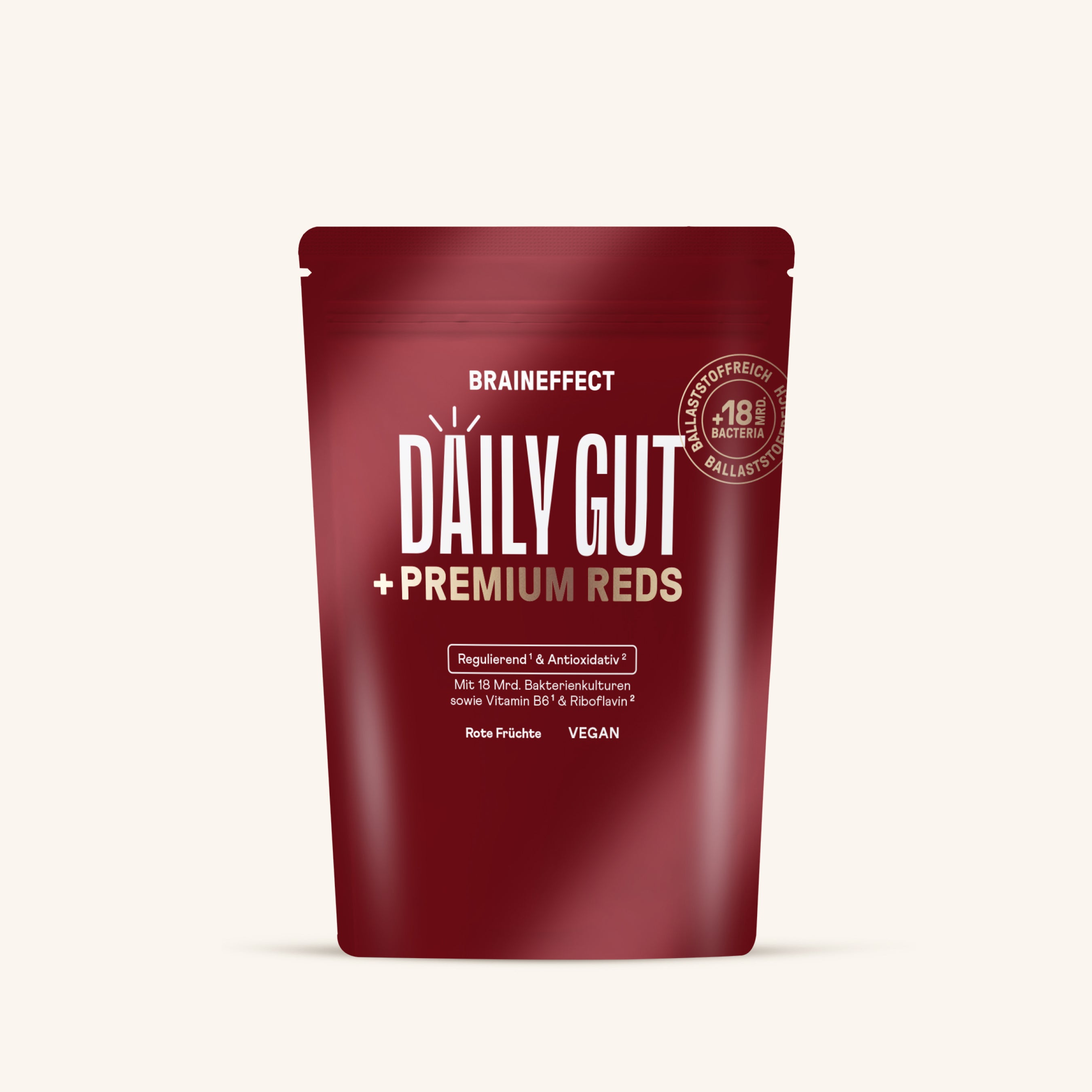Here comes concentrated antioxidant power: Vitamin E is essential for the body's defenses because it protects cells from oxidative stress . Learn why this is particularly beneficial for your cognitive abilities here.
Table of contents
1. What is vitamin E?
Vitamin E isn't just a single nutrient: Vitamin E encompasses a variety of antioxidants that protect the body from free radicals . Furthermore, fat-soluble vitamin E is one of the essential vitamins that the body cannot produce itself .
Therefore, vitamin E should be consumed regularly through food so that the cells are optimally supplied – with all forms of the vitamin E family.
Vitamin E primarily includes four different tocopherols (alpha, beta, gamma and delta) and four tocotrienols (alpha, beta, gamma and delta).
They all occur naturally in plants and can be found in the cell walls of humans and animals – this is where their antioxidant effect in cell protection comes into play.
The best-known micronutrient of the vitamin E group is alpha-tocopherol , which is the most abundant in the body and accounts for up to 90 percent of the vitamin E content.
However, recent studies have shown that this alpha form has the poorest antioxidant properties. Gamma tocopherol, for example, is much more effective when it comes to potentially inhibiting inflammation. [1]
Additionally, it has become clear in recent years that tocotrienols are the real heroes in the antioxidant complex. They are said to be 40 to 60 times more effective than the previously highly praised alpha-tocopherol. [2]
Furthermore, vitamin E only develops its full effect in combination with other vitamins , especially vitamin C. Since vitamin E acts as a radical scavenger, binding to free oxygen radicals and thus rendering them harmless, another antioxidant is needed for neutralization.
Take-Home Message #1: Vitamin E is actually a family of different antioxidants. The most important of these are tocopherols and tocotrienols.
2. What is the general effect of vitamin E?
It's hard to avoid it when shopping: skin care products advertise added vitamin E, claiming it protects skin and hair from aging and environmental influences. There's actually some truth to this, as vitamin E primarily contributes to protecting cells from oxidative stress.
And since our entire body is made up of cells that are involved in all metabolic processes, vitamin E has a positive effect on many areas. As a radical scavenger, for example, it ensures that...
- the skin does not age so quickly.
- the immune system functions normally
- protein metabolism works.
- the nervous system can do its work.
- the brain cells are protected.
- Tissues and brain are supplied with oxygen.
- no deposits form in the blood vessels.
A positive effect on fertility, however, has not been conclusively proven. However, it has not been refuted either, which is why many men still rely on vitamin E as a boost for their virility and improved sperm quality. [3]
Take-home message #2: Vitamin E protects cells from oxidative stress and is therefore essential for many metabolic processes.
3. The effect of vitamin E on the brain and muscles
In addition to supporting the immune system and inhibiting inflammation, tocotrienols are particularly interesting for cognitive abilities . Researchers have found initial evidence that they have a positive effect on brain performance. [4]
In addition, after prolonged intake of 200 mg, it also appears to be able to protect your brain from the spread of tissue damage. [5] Due to its lipophilic properties, vitamin E is very well absorbed by brain cells , where it can unfold its full protective power.
However, in order to be able to definitively investigate this hypothesis, many more clinical studies are needed in this positive context!
Since most free radicals are produced in the brain and muscles during metabolism, adequate cell protection against oxidative stress is essential here.
Athletes, especially those in high-performance sports, generate a lot of oxygen radicals due to the high demands on their muscles, which must be intercepted before they can cause damage to the cells.
An optimal supply of vitamin E , in the context of oxidative protection, is an excellent defense against injuries to muscle fibers.
Take-home message #3: The cells in the brain and muscles are particularly exposed to oxidative stress and need adequate protection from free radicals.

4. What are the symptoms of a vitamin E deficiency?
If the cells lack vitamin E, all bodily functions can be impaired . The signs of a vitamin E deficiency are therefore very diverse and cannot always be specifically identified .
Among other things, there are negative influences on:
- concentration
- coordination
- the muscles
- Cycle
The good news: With a balanced, nutrient-rich diet, vitamin E deficiency is extremely rare . This is because vitamin E is stored in the cells and remains available as a reserve for quite some time.
Deficiency symptoms only occur if you follow a very one-sided diet over an extended period of time or completely avoid fats and oils. However, due to the stored vitamin E reserves in the liver, the first signs of deficiency may only appear after several years of undersupply .
Take-home message #4: Vitamin E deficiency is rare, but can manifest itself in symptoms such as muscle weakness and concentration problems.
5. Foods with vitamin E
Those who eat a balanced, wholesome diet generally don't need to worry about a vitamin E deficiency. Plant and animal foods contain all forms of the vitamin E family, as well as the various vitamins that support its antioxidant effects.
Women should consume about 11 to 12 milligrams of vitamin E daily, and men about 13 to 15 milligrams . Pregnant women have an increased need .
Natural cooking oils, for example, are excellent sources of vitamin E, such as:
- Wheat germ oil
- olive oil
- Sunflower oil
- Corn germ oil
- sesame oil
- Coconut oil
Fish should also be on the menu regularly, for example in the form of:
- mackerel
- herring
- Salmon
- crabs
Nuts and seeds are also good sources of vitamin E, including:
- Sunflower seeds
- Almonds
- Hazelnuts
- pine nuts
- Walnuts
- sesame
- pumpkin seeds
Fruits and vegetables containing vitamin E also include
- spinach
- tomatoes
- Beetroot
- Broccoli
- cabbage
- pumpkin
- mango
- papaya
- olives
Take-home message #5: A balanced diet includes all important forms of vitamin E.
Examples of the amount of foods (in g) that cover your daily requirement of vitamin E

6. Vitamin E as a dietary supplement
Normally, a vitamin E deficiency rarely occurs with a varied and healthy diet. However, in some cases it may be beneficial to take additional vitamin E, for example in the form of vitamin E capsules.
Anyone who does a lot of sport , has to constantly perform at peak mental levels or has problems with their digestion can compensate for their increased needs with high-quality supplements .
7. Can you overdose on vitamin E?
With many vitamins, an overdose is simply excreted from the body without causing any side effects. This is also true for vitamin E up to a level of 300 milligrams.
However, if you cover your vitamin E needs through your diet, it is almost impossible to consume too much of it.
However, if you support your vitamin levels long-term with vitamin E capsules or similar supplements, you may overdose . This increases your risk of:
- Bleeding
- Gastrointestinal complaints
- Muscle weakness
- Headache
- fatigue
In addition, too much vitamin E can affect the absorption of other vitamins, since a certain balance of the individual nutrients should exist for an optimal vitamin supply.
Take-Home Message #6: Although overdose is rare, caution should be taken when taking additional vitamin E.
8. Conclusion
Vitamin E isn't actually a single vitamin, but rather a collective term for several different antioxidants. It primarily has a cell-protective effect and thus also affects your immune system and many other processes in your body.
9. Sources
[1] https://academic.oup.com/ajcn/article/74/6/714/4737392
[2] https://www.ncbi.nlm.nih.gov/pubmed/25435896
[3] https://www.ncbi.nlm.nih.gov/pubmed/22935557
[4] https://www.ncbi.nlm.nih.gov/pmc/articles/PMC5147513/
[5] https://www.ncbi.nlm.nih.gov/pubmed/24699052
{{widget type="egproducts/list_featured" template="elegento/products/listslider.phtml"}}














